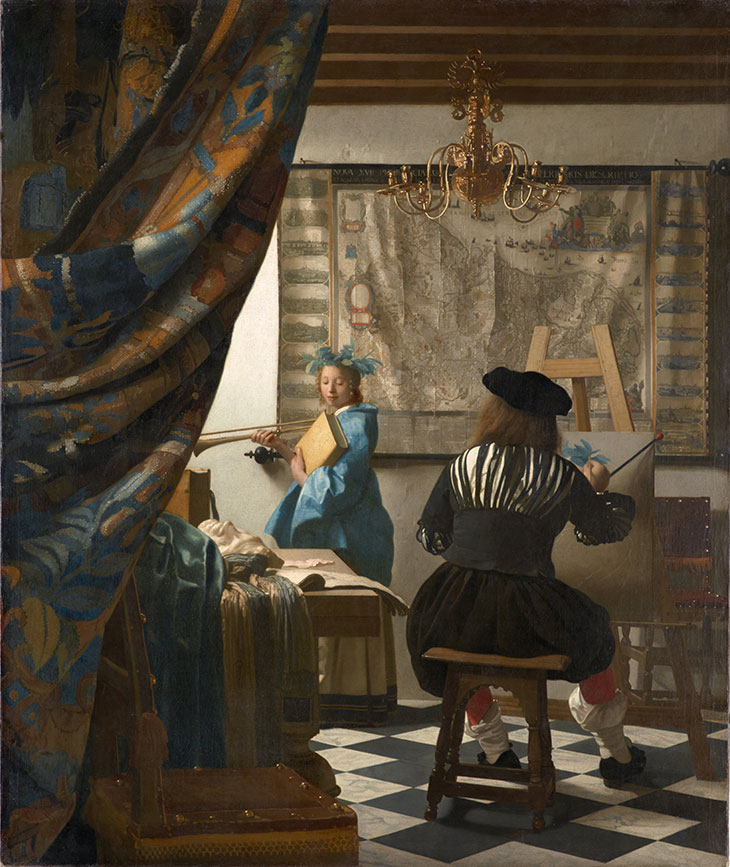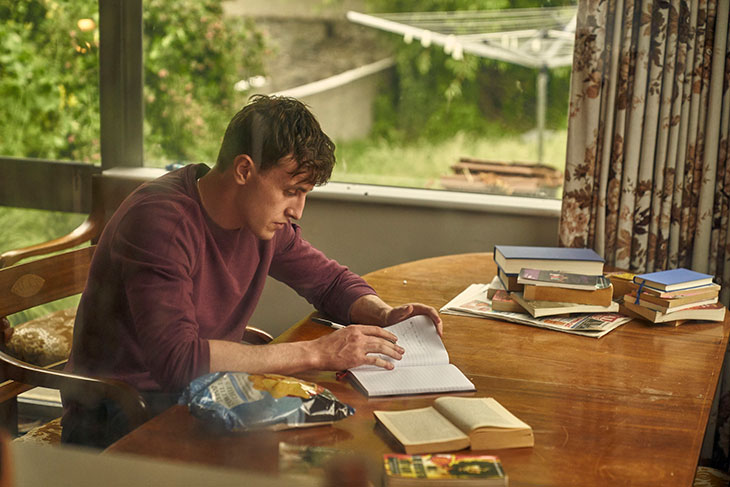The eighth episode of the zeitgeisty BBC/Hulu adaptation of Sally Rooney’s Normal People is framed by encounters with two paintings in European museums: Vermeer’s The Art of Painting (c. 1666–68) at the Kunsthistorisches Museum in Vienna and Duchamp’s Nu (esquisse), jeune homme triste dans un train (1911–12) at the Peggy Guggenheim Collection in Venice. The episode transports its young protagonists, Connell and Marianne, from Ireland to Italy. Connell has been backpacking around Europe all summer before turning up at Marianne’s family’s villa in the sunbaked Italian hills. The previous seven episodes have traced Connell and Marianne’s tempestuous relationship from school in the west of Ireland to university at Trinity College Dublin. Under steely Irish skies, they have embarked on a secret sexual relationship, found a remarkable connection, endured separations due to miscommunications and missed opportunities, and established a fragile friendship that can never quite shake their crackling romantic energy. In storybook Italian piazzas, they renew their bond, even as Marianne’s snobbish boyfriend Jamie stews nearby. And much of that bond is represented through the visual language of art.
When asked what his favourite part of his European tour has been, Connell answers laconically, ‘Standing in front of Vermeer’s The Art of Painting was pretty good.’ His travelling companion adds that Connell actually stood in front of the painting for a whole day, a scene that is shown at the beginning of the episode, Connell’s dirty Stan Smiths contrasting with the museum’s polished parquet floors. Marianne’s new boyfriend scoffs at the idea of spending a whole day looking at one painting, a character beat that shows Jamie’s intrinsic incompatibility with Marianne. She, of course, understands why Connell would stand in front of the Vermeer all day, and recommends that the group head to Venice to visit the Guggenheim and see Duchamp’s painting. ‘You could stand in front of it for a whole day,’ Marianne tells Connell. ‘It’s a nude,’ she adds, winking at their own past intimacies and hinting at future ones.

The Art of Painting (c. 1666–68), Johannes Vermeer. Kunsthistorisches Museum, Vienna
While Rooney’s novel only mentions Connell’s fascination with the Vermeer in passing, the television adaptation uses European art to communicate overlapping themes, particularly class and Connell’s own artistic development. Connell and Marianne first come into contact outside of school because his mother cleans Marianne’s mansionlike family home. For Connell, winning a scholarship provides his first and only opportunity to experience continental travel, while Marianne has grown up with privilege. Their encounter in Italy marks the first time that Connell and Marianne acknowledge the differences in their economic backgrounds, the basic inequalities between them. ‘Why hasn’t this come up before?’ she asks him. It’s a scene that captures perfectly both the novel’s and the adaptation’s subtle critique of capitalism and their embrace of alternative systems of value – like making and appreciating art.
Connell’s admiration of the Vermeer is also emblematic of another of Normal People’s emerging themes: the character’s own development as a writer. The Art of Painting is considered Vermeer’s most incisive metacommentary on his own work. It is one of only a few signed paintings by the artist, and he famously never sold it, keeping it in his studio for prospective buyers to see. Vermeer theatrically depicts an artist’s studio, the painter (with his back to us) rendering the blue tufts of a model’s wreath of laurels on his canvas. Any number of interpretations have been made of the painting’s ambiguities and themes, but what matters most in the world of Normal People is how it sheds light on Connell’s evolution. Over the course of the series, he transitions from idle scribbling in a journal to submitting original fiction for publication and eventually editing a literary magazine. His regard for the Vermeer completes another step in the Künstlerroman that Rooney nestles within her non-traditional love story.

Connell (Paul Mescal) in episode six of Normal People. Photo: Enda Bowe; courtesy BBC/Element Pictures/Hulu
The trip to Venice to visit the Duchamp does not appear in Rooney’s novel; it’s one of many slight but effective additions or alterations to the source material made by the show’s screenwriters to translate the book into the visual medium. (Rooney co-wrote the first six episodes with playwright Alice Birch; the final six are divided between Birch and Mark O’Rowe.) The most striking and sometimes polarising element of Rooney’s style is the extreme interiority she grants her characters. Like the best 19th-century novelists (she’s been compared with Jane Austen and Henry James), Rooney uses free-indirect style and familiar detail to bring her characters’ normal messiness alive. Without these narrative moments of living and breathing with the protagonists, the TV adaptation must choose other languages for getting viewers inside the characters’ heads. (There are no voiceovers, mercifully.)
Art proves the ideal medium, with the early cubist-inspired painting by Duchamp revealing another aspect of Connell’s personality and Marianne’s perception of him. On the one hand, the painting of a ‘sad young man on a train’ literalises what Connell’s been doing all summer – interrailing across Europe – but, with its frenetic multiplicity of lines conveying the movement of train and subject, it also mirrors the schisms and depressive qualities in Connell’s personality to which only Marianne has access. The episode’s final scene shows Marianne and Connell standing together in front of the Duchamp, viewers who are themselves being viewed; the audience understands both the closeness of the connection between the characters and also the distances, in class and communication, that separate these sad young people.

Vermeer, Duchamp and Sally Rooney
Connell (Paul Mescal) and Marianne (Daisy Edgar-Jones) on holiday in Italy in episode eight of Normal People. Photo: Enda Bowe; courtesy BBC/Element Pictures/Hulu
Share
The eighth episode of the zeitgeisty BBC/Hulu adaptation of Sally Rooney’s Normal People is framed by encounters with two paintings in European museums: Vermeer’s The Art of Painting (c. 1666–68) at the Kunsthistorisches Museum in Vienna and Duchamp’s Nu (esquisse), jeune homme triste dans un train (1911–12) at the Peggy Guggenheim Collection in Venice. The episode transports its young protagonists, Connell and Marianne, from Ireland to Italy. Connell has been backpacking around Europe all summer before turning up at Marianne’s family’s villa in the sunbaked Italian hills. The previous seven episodes have traced Connell and Marianne’s tempestuous relationship from school in the west of Ireland to university at Trinity College Dublin. Under steely Irish skies, they have embarked on a secret sexual relationship, found a remarkable connection, endured separations due to miscommunications and missed opportunities, and established a fragile friendship that can never quite shake their crackling romantic energy. In storybook Italian piazzas, they renew their bond, even as Marianne’s snobbish boyfriend Jamie stews nearby. And much of that bond is represented through the visual language of art.
When asked what his favourite part of his European tour has been, Connell answers laconically, ‘Standing in front of Vermeer’s The Art of Painting was pretty good.’ His travelling companion adds that Connell actually stood in front of the painting for a whole day, a scene that is shown at the beginning of the episode, Connell’s dirty Stan Smiths contrasting with the museum’s polished parquet floors. Marianne’s new boyfriend scoffs at the idea of spending a whole day looking at one painting, a character beat that shows Jamie’s intrinsic incompatibility with Marianne. She, of course, understands why Connell would stand in front of the Vermeer all day, and recommends that the group head to Venice to visit the Guggenheim and see Duchamp’s painting. ‘You could stand in front of it for a whole day,’ Marianne tells Connell. ‘It’s a nude,’ she adds, winking at their own past intimacies and hinting at future ones.
The Art of Painting (c. 1666–68), Johannes Vermeer. Kunsthistorisches Museum, Vienna
While Rooney’s novel only mentions Connell’s fascination with the Vermeer in passing, the television adaptation uses European art to communicate overlapping themes, particularly class and Connell’s own artistic development. Connell and Marianne first come into contact outside of school because his mother cleans Marianne’s mansionlike family home. For Connell, winning a scholarship provides his first and only opportunity to experience continental travel, while Marianne has grown up with privilege. Their encounter in Italy marks the first time that Connell and Marianne acknowledge the differences in their economic backgrounds, the basic inequalities between them. ‘Why hasn’t this come up before?’ she asks him. It’s a scene that captures perfectly both the novel’s and the adaptation’s subtle critique of capitalism and their embrace of alternative systems of value – like making and appreciating art.
Connell’s admiration of the Vermeer is also emblematic of another of Normal People’s emerging themes: the character’s own development as a writer. The Art of Painting is considered Vermeer’s most incisive metacommentary on his own work. It is one of only a few signed paintings by the artist, and he famously never sold it, keeping it in his studio for prospective buyers to see. Vermeer theatrically depicts an artist’s studio, the painter (with his back to us) rendering the blue tufts of a model’s wreath of laurels on his canvas. Any number of interpretations have been made of the painting’s ambiguities and themes, but what matters most in the world of Normal People is how it sheds light on Connell’s evolution. Over the course of the series, he transitions from idle scribbling in a journal to submitting original fiction for publication and eventually editing a literary magazine. His regard for the Vermeer completes another step in the Künstlerroman that Rooney nestles within her non-traditional love story.
Connell (Paul Mescal) in episode six of Normal People. Photo: Enda Bowe; courtesy BBC/Element Pictures/Hulu
The trip to Venice to visit the Duchamp does not appear in Rooney’s novel; it’s one of many slight but effective additions or alterations to the source material made by the show’s screenwriters to translate the book into the visual medium. (Rooney co-wrote the first six episodes with playwright Alice Birch; the final six are divided between Birch and Mark O’Rowe.) The most striking and sometimes polarising element of Rooney’s style is the extreme interiority she grants her characters. Like the best 19th-century novelists (she’s been compared with Jane Austen and Henry James), Rooney uses free-indirect style and familiar detail to bring her characters’ normal messiness alive. Without these narrative moments of living and breathing with the protagonists, the TV adaptation must choose other languages for getting viewers inside the characters’ heads. (There are no voiceovers, mercifully.)
Art proves the ideal medium, with the early cubist-inspired painting by Duchamp revealing another aspect of Connell’s personality and Marianne’s perception of him. On the one hand, the painting of a ‘sad young man on a train’ literalises what Connell’s been doing all summer – interrailing across Europe – but, with its frenetic multiplicity of lines conveying the movement of train and subject, it also mirrors the schisms and depressive qualities in Connell’s personality to which only Marianne has access. The episode’s final scene shows Marianne and Connell standing together in front of the Duchamp, viewers who are themselves being viewed; the audience understands both the closeness of the connection between the characters and also the distances, in class and communication, that separate these sad young people.
Unlimited access from just $16 every 3 months
Subscribe to get unlimited and exclusive access to the top art stories, interviews and exhibition reviews.
Share
Recommended for you
Venus enlargement? Marlene Dumas takes on Shakespeare’s erotic verse
The artist is one of few to have attempted to illustrate Venus and Adonis
‘Hilary Mantel brings her characters to life with as much clarity as a Holbein portrait’
The novelist’s Thomas Cromwell trilogy suggestively fills in what art historians can only guess at
Peggy Guggenheim steals the show in Florence
A show about the Guggenheim’s art collections is really about the battle between Peggy and Solomon